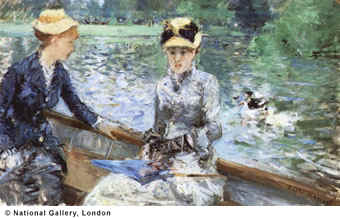
Lesson #4
Berthe Morisot (more-ee-SOH)
French, 1841-1895
Summer’s Day, about 1879
Oil on canvas
18 x 29 5/8 in.
© The National Gallery, London, England
Subject
In this, perhaps her most famous painting, Berthe Morisot captures two apparently middle-class ladies in a moment of quiet thought. (The women have not been identified and probably are models who posed for Morisot.) They float lazily in a boat on the lake in the Bois de Boulogne, a large, wooded park on the edge of Paris. Morisot painted them as if she were sitting next to them, and well she might since the fashion- able Bois was not far from her home. It was con- sidered safe and accept- able for a woman of Morisot’s social class to stroll, picnic, and even paint here. Unlike her male counterparts who could set up an easel in city streets and café-concerts, Morisot stayed close to home and painted real-life moments from her immediate world - elegant women getting out of bed, relaxing in the garden, or dressing in their boudoir for a night at the opera.
Style
Intrigued by the play of light on her subjects, Morisot painted the swans, the reflections in the lake, and the ladies themselves in the quick, zigzag brushstrokes for which she’s known. In typical Impressionist style, the composition is off center, with the blue-coated woman partially cropped by the edge of the scene. Yet notice how similar brush- strokes throughout the painting pull it together. This sketchy texture captures Morisot’s open-air "impression" of the moment, though art critics of the time often mistook her loose style for sloppiness.
"Why, with her talent, does she not take the trouble to finish?" complained one early reviewer. But other critics raved about Morisot’s pearly, soft color harmonies. "She grinds flower petals onto her palette," gushed one writer, "so as to spread them later on her canvas...."
Artist
Berthe Morisot struggled to be taken as seriously as male counterparts of the time. Reared in a conservative, cultured family, she received the art lessons given all young ladies of her class. She was excluded, as a woman, from nude life-drawing classes, but her ability emerged in paintings of the outdoors and domestic scenes.
She married the brother of her mentor, Èdouard Manet, and exhibited in all but one Impressionist show. During her lifetime, Morisot’s canvases often fetched slightly higher prices than those of her male colleagues, but she remained modest. She had merely wanted to capture "something of what goes by...the smallest thing," she wrote in later life. "An attitude of Julie’s (her daughter), a smile, a flower, a fruit, the branch of a tree, any of these things alone would be enough for me."
Looking Questions
What type of location do you see in the painting?
What time of day is it?
Describe the clothes that the women are wearing.
* Although there are very few outlines, what other kinds of lines do you see in the painting? Where do you see zigzag, curvy, or straight lines? What kinds of lines repeat?
* Is there any black in the picture? Where?
* The painting shows us part of the boat and the two women riding in it. What else do you think was in the boat outside of our view? Do you think the artist or someone else was in the boat?
Activities
The Arts
Many colors, lines, and shapes are combined to create the illusion of sunlit water in this painting. Have the students create drawings of water. Use felt tip pens to apply color in short zigzag strokes. Experiment with a variety of colors over the page rather than coloring in large blocks of one color. Draw a river or seascape, or arrange a still life with a glass of water as one of the objects.
Math or Science
Ask the students to count the different blues they see in this reproduction of Morisot’s painting.
How many greens and yellows are there? Are any other color groups represented? If you were designing a set of crayons for the colors in this painting, how many would be in the box? What would you name some of the colors? Just for fun, see if you can give them all science-type names, like Sulfur Yellow!
Language Arts
The two women appear to be enjoying a relaxed, sunny day. Have your students write a dialogue between the two women in the boat. First, create a one-line description of the characters. Next, create a dialogue between them. Perform the play for the rest of the class. You may want to include the artist as another character in your play.
Social Studies
Ask your students to imagine that they are riding in the boat with the two women. Perhaps they are reporters interviewing the women about their lives. Write a short newspaper article from this interview. Read the information section about the artist and painting to give the articles more details.
Continue reading on to the next page, #5: Monet, The Cliff at Fécamp.
